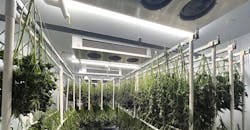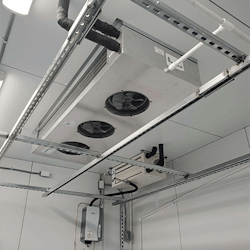Cannabis is a sneaky industry. By that, I mean when the industry began, long before cannabis mega-production, the options for environmental control were limited to 'o? the shelf' solutions. We're talking about dehumidifiers, air conditioners, and fans. No doubt, some fantastic flower has been produced with these tools, but the lack of tight control, repeatability and consistency plague growers of all sizes.
So why is it sneaky? Well, these rudimentary tools and methods, never designed for true process control, have snuck into the highest echelons of commercial cannabis.
Most of the industry's research and development centers around the grow room. But very little work has been done around post-harvest processing. Drying, curing, and storage are equally as important as growing when it comes to finishing a harvest. Traditional HVAC equipment is no longer the industry's gold standard (was it ever?). We must bring new technology to the industry that raises the bar and delivers precision, repeatable, consistent control in every climate year-round.
Some new data published by The Cannabis Research Coalition (CRC) is quite compelling and speaks to the benefits of improved controls during post-harvest. Precisely controlling vapor pressure in the post-harvest space versus chasing relative humidity and temperature delivers a significantly better product. For cannabis, this means products with higher terpenes, more extended shelf stability, smoother smoke, and higher yields. Some fundamental principles of physics can be applied in these post-harvest spaces to achieve great results for your cannabis clients.
Traditional HVAC is designed for comfort cooling. The latent and sensible ratio is typically a predetermined value established by the equipment manufacturer. We also consider controlling dry bulb temperature and relative humidity for the drying process. The issue with this strategy is that relative humidity is an uncontrollable variable resulting from two variables: dry bulb temperature and vapor pressure (dew point). When using equipment with a fixed sensible to latent ratio, maintaining a controlled vapor pressure in the drying space is nearly impossible.
The ultimate goal of proper drying is to remove unbound water from the product to achieve a target water activity. At a target water activity of 0.6, you establish a shelf-stable product where mold and microbes can no longer grow. The best way to accomplish this target water activity is to place the fresh product to be dried (cannabis flower in this case) in a space with a stable and controlled vapor pressure and allow the product with a high vapor pressure to come to equilibrium with the space. By using this method, you eliminate the possibility of over drying the product. Also, maintaining a constant vapor pressure eliminates the kinetic damage caused to the fragile trichomes by otherwise varying vapor pressure caused by conventional HVAC equipment.
In the case of cannabis, the target is 14 Millibars at 68 degrees F. Once the product reaches this target level, no more water will be removed, so the danger of over drying can be completely eliminated. When cannabis is overdried, it loses saleable weight. So, a properly controlled space can increase a cultivator's yield and profitability. The return on investment makes a compelling story for upgrading an existing system performing below par. A traditional HVAC system could very well be draining profit from your customers. Cannabis cultivators struggle with plenty of things, from regulatory matters to managing personnel. As a service industry, we can introduce new technologies that improve product quality for our customers and give them one less thing to worry about.
Sponsored by:



